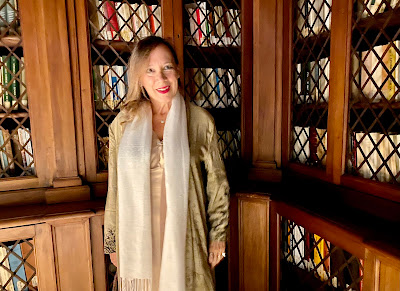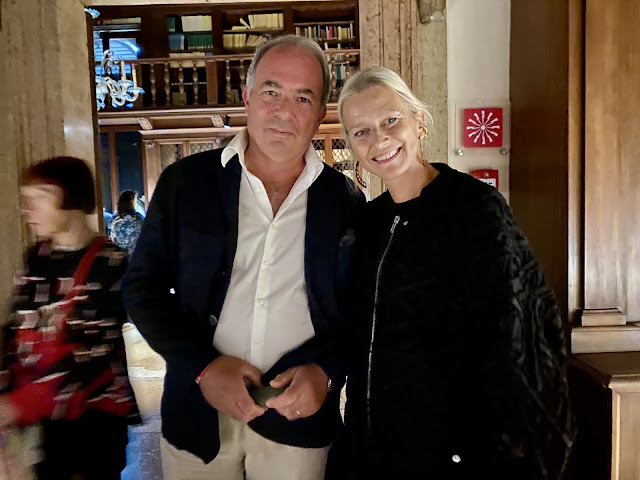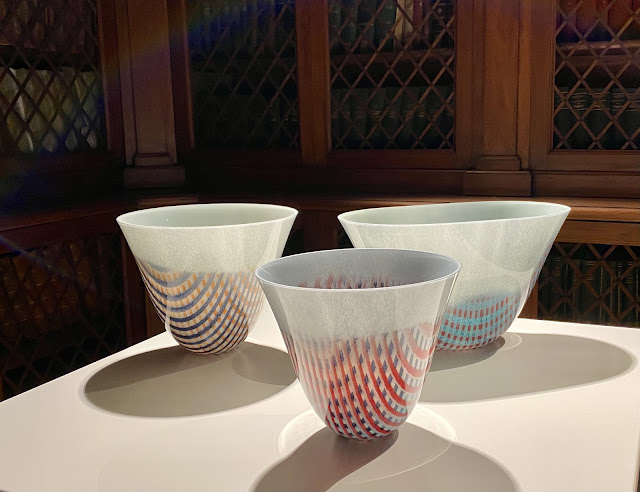Palazzo Loredan - Istituto Veneto di Scienze, Lettere ed Arti
The Venice Glass Week HUB - Preview Highlights
The Venice Glass Week HUB - organised by The Venice Glass Week - until September 22 - offers a stunning showcase of glass artistry, featuring an array of captivating installations in Campo Santo Stefano at the historic Istituto Veneto di Scienze, Lettere ed Arti, housed in the grand Palazzo Loredan. Within the opulent piano nobile rooms, visitors can admire an impressive collection of glass works by both national and international artists. These curated pieces, set against the backdrop of Venetian architectural splendor, highlight the innovation, creativity, and craftsmanship of the contemporary glass-making world, celebrating Venice's rich tradition as a global center for glass artistry.
Pietro e Riccardo Ferro - Yellow Eye
Pietro and Riccardo Ferro's work Yellow Eye was made in a furnace on Murano, and is the result of five superimpositions of colour. The glass is cold-worked freehand, using grinding wheels of various sizes and shapes. By digging for the innermost layers of the glass, the Ferro brothers create a unique design that distinguishes their art.
Sebastiano Pedrocco , Giovanna Palandri and Sandro Franchini
The Pistillo collection by Michela Cattai captures the beauty and unpredictability of nature through Murano's blown glass technique. Each freehand-shaped piece, in amber tones, reflects the timeless elegance of its surroundings. With its oblique form, Pistillo symbolizes nature's constant evolution, blending traditional Murano craftsmanship with a modern design language. It’s a tribute to Italian artistry, uniting past and present in glassmaking.
Michela Cattai - Pistil
The new collections of lamps and sculptures by Emmanuel Babled, where the primordial force of nature and the elegance of contemporary design merge into unique works of art. This exhibition highlights the craftsmanship of Venini's masters and the creative innovation that characterize Babled's work.
Emmanuel Babled. Shadow and Lights - Glass and Fire:
Lamps and Sculptures
Emmanuel Babled and Silvia Damiani
This Art and Science installation shows for the first time the synergy between Simone Crestani and Dr. Ioannis Michalou(di)s, a Greek artist working on the ethereal silica aerogel - a nanomaterial made of 99% air and 1% glass, used by NASA to collect stardust. The artists are merging their techniques to create an intriguing collection of three artworks/allegories on the last layer of planet Earth, our blue and golden breath, our sky in danger.
Simone Cristani and Ioannis Michalou(di)S
S.O.S.-Save Our Skies
Patrick Vangheluwe, Daniela Ferretti and Dries van Norten
In the Triangle installation, Milan Krajíček presents two glass objects created using a unique authorial technique combining, among other techniques, glass melting in a mould, glass grinding and then thermal deformation, etc. In Vertical Slit, he deliberately cuts a perfect shape in order to distort and deform the perception of order.
Milan Krajíček - Triangle
The traumatic Turkish invasion of Cyprus in 1974 drove Yorgos Papadopoulos to create art that helps to build bridges. Inspired by the amulets used against the - evil eyes - these works were conceived as conveyors of good rather than for protection against evil. Conceptually abstracted, they promote certain values, concepts and attitudes; in this particular case they represent the importance of respect.
Yorgos Papadopoulos - Eye of Reverence I
Among her various approaches in working with glass, with these pieces Françoise Bolli proposes a journey from the manifestations of the material to her questions about the technique known as thermoforming. How can her explorations be read poetically and in a progressive manner, when coherence is not immediately apparent?
Françoise Bolli - Special Vessel
Irina Boyko’s collection was inspired by the sketches of Russian suprematists K.Malevich and N.Suetin. The fundamental principle of Suprematism lay in Weightlessness. In the artist's interpretation, the energy of the universe, whether male or female, carries no weight, yet it propels each of us forward towards the new. Slabs of thick and intricately processed glass, used in every object, represent streams of energy, transcending the Earth.
Irina Boyko - Weightlessness
The Caretakers - tells this story through fragile, exposed, vulnerable organ like glass shapes clinging to life on twisted recycled metal or rope support structures. The glass represents the human part – vulnerable, exposed and disabled - while the metal/rope is a kind of a caregiver. This thematic process of uncovering tenderness versus brutality is in constant transformation in my work.
Maria Koshenkova - The Caretakers
Made entirely of recycled glass olive oil jars, this work highlights the intrinsic qualities of industrial glass as a raw material for artistic expression. Deconstructed and reassembled, the jars take on new life and new meaning independent of their previous function. Jewish tradition teaches - Do not look at the jar, rather at what it contains. These pieces challenge that notion, inviting us to consider the jar itself and its creative potential.
Stefanie Jadd Susnow - Consider the Jar
Marisa Convento
Karesansui series﹟1 is inspired by the artist's fascination for Japanese dry gardens. These gardens can be found around Buddhist temples, where you can observe an atmosphere of meditation and contemplation which ensures a divine relationship with the gods. The carefully scraped gravel represents scenic elements of nature. This project of sculptural vases embodies a feeling of space and infinity of time.Tracing and movement are the leitmotif of the entire series.
Camille Jacobs - Karesansui series﹟1
On simply shaped, almost architectural objects the Artist shows power and boldness of these materials. She forms the object from the material only by setting a simple geometric shape, reducing the creation to its essence. Thanks to unique light feature, glass itself is a fascinating material. Concrete without depth, it is the opposite of glass. Both materials are essentially a reduction of the beauty of matter, but each in its own way.
Katarína Pozorová - Relationships of the Matter
Benedetta Gaggia Giannelli Viscardi
The Mosaic Eye interactive installation is based on the triangular-hexagonal structure of the eyes of insects. The work was created from glass, concrete, and light. In the concrete grid eyes, the sandblasted glass lenses serve as a projection surface for video mapping. The eyes' gaze follows the audience's movements with the help of special sensors. This work is a visual reference to the angelic guardians, who constantly watch people.
Csilla Szilágyi - In collaboration with László Pala Papp - Mosaic Eye
The work is made of different compositions of transparent and coloured glass cubes of different sizes, installed regularly or randomly. Inspired by children's toys, the artist represents the concept of life as a game. Sayed Waked invites us to keep the passion and enjoyment of life, appreciate every moment and not take life too seriously, as there are always new opportunities available.
Sayed Waked - My New Game
The Fragment Feast object is an homage to the diverse world of glass, combining various glass types into the image of a three-dimensional space. It invites the viewer to appreciate the versatility of glass while highlighting the creative possibilities of repurposing materials into stunning artistic expressions. In this sense it is not only meant as a visual feast but also a testament to sustainability and innovation in contemporary glass design.
Jakub Janďourek - Fragment Feast
The piece Observation Hill uses as reference the multiple views of the same hill in Antarctica that were painted in watercolour by the Antarctic explorer Edward Wilson - 1872-1912. Anamorphic versions of these archival images are painted in watercolour onto sandblasted glass. These distorted shaped landscapes are corrected when reflected in the mirrored spheres, creating views into miniature worlds.
Polly Gould - Observation Hill






























